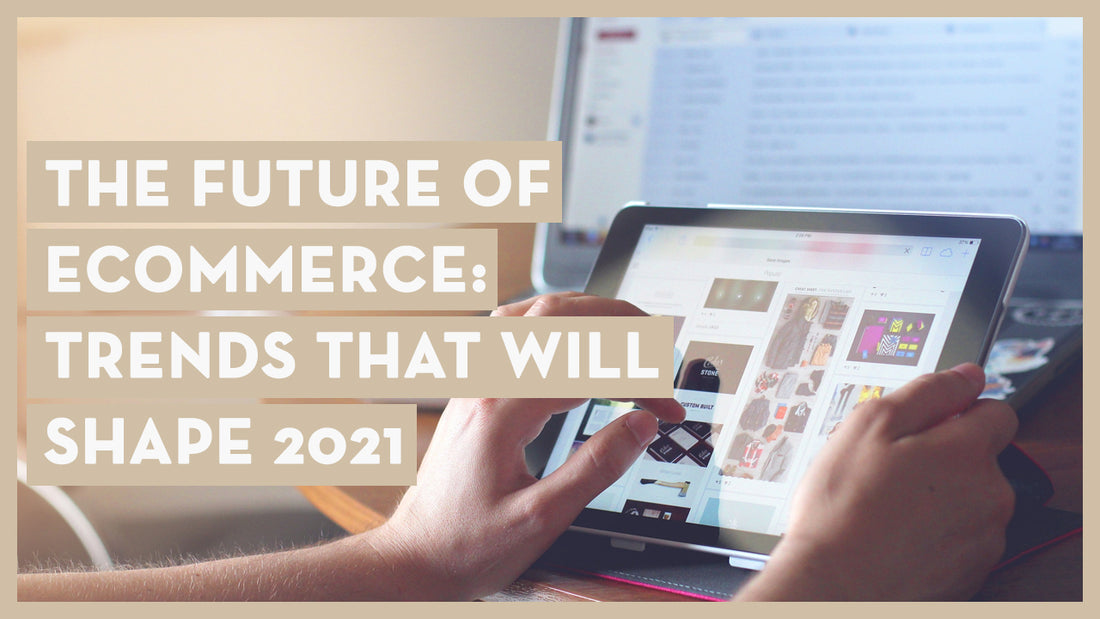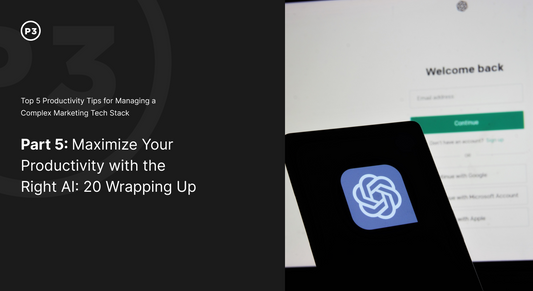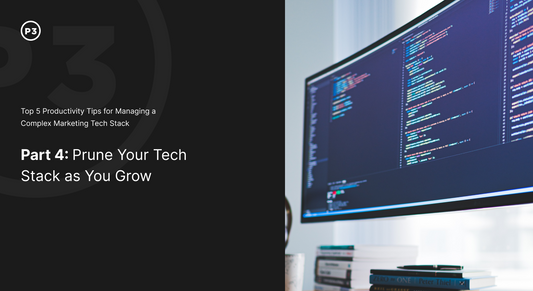Inside 8 Major Trends That Will Shape Your 2021
From the global pandemic to the rise of the Savage dance on Tik Tok, 2020 has been a challenging year to interpret. But in many ways, the very same disruptions that have sewn confusion into our daily lives have also clarified the pathway forward for eCommerce merchants.
In August, IBM released their annual “U.S. Retail Index,” which contends that eCommerce penetration into retail sales is now 5 whole years ahead of where we thought it would be in 2019. The wholesale, rapid shift toward click-to-buy behavior underpinning this growth to date has been further reinforced by innovative, agile retailers and technology providers eager to meet consumers where they are.
Working at the intersection where platforms, brands, and consumers connect, P3 has developed a comprehensive view of where each group is going next. Read on to set yourself up for your most successful 2021.
NEW CONSUMER BEHAVIORS
1. An Accelerated Shift Toward Mobile Shopping
Since the beginning of COVID-19 lockdowns in March, the yearslong global shift toward mobile browsing & shopping has only accelerated. According to data from Statista, By the end of 2021, mobile devices are expected to make almost 73% of total eCommerce sales. In addition, 30% of online shoppers are likely to abandon their carts in the middle of shopping if using a website that isn’t mobile-friendly. Within P3’s own customer base, we’ve seen the proportion of customers shopping on mobile increase by anywhere from 25% - 200% from 2019 to 2020, as compared with sessions on desktop.
Given that consumers’ mass exodus to mobile was already well underway when the pandemic struck, there is no reason to believe that this trend will reverse itself. That’s why across our client base, we are recommending increased investment in the mobile custom experience. Going mobile-first is no longer about improving accessibility, or even about widening the tech-savvy audience share you can attract directly from social media. It’s about maximizing conversion, period.
P3 RECOMMENDS
• Prioritizing your mobile customer experience to maximize online earnings
• Investing in a friction-free cart experience with convenient payment options for your mobile users. P3 has consistently seen lower abandoned cart rates and higher conversion rates on mobile after integrating one-click checkout and buy now, pay later payment options like Quadpay for our clients.
2. An Emerging Preference For Flexible Fulfillment & Payment Options
According to the results of an eCommerce customer survey released by Salesforce in October, 88% of customers expect companies of all kinds to accelerate digital initiatives due to the pandemic, while 83% of customers now expect retailers to provide flexible shipping and fulfillment options such as buy-online-pick-up-in-store (BOPIS). These expectations match the latest eCommerce usage data from Digital Commerce 360, which reflects a 500% YOY increase in BOPIS usage since the pandemic began.
BOPIS & other blended pickup options also offer reciprocal enticements to merchants beyond improved customer conversion and retention: Before the pandemic, BizRate Insights found that up to 79% of consumers were making additional in store purchases when retrieving their BOPIS orders, while returning orders fulfilled via BOPIS at significantly lower rates. And unlike traditional online orders, BOPIS orders cost merchants nothing to ship.
Looking beyond BOPIS, consumers have demonstrated a growing appetite for safer contactless payment alternatives across the board. By the end of April, Mastercard was reporting that over 50% of American consumers now use contactless checkout options, and that around a third of American shoppers identify contactless payment as their go-to method for making purchases. Merchants selling overseas should pay special attention to contactless, since adoption rates rise substantially in many places outside of the U.S., where contactless had a stronger foothold before the pandemic.
For all of these reasons, you won’t find an analyst worth their pocket protector who’s predicting that blended checkout and contactless payments will disappear once the threat posed by COVID is eliminated.
P3 RECOMMENDS
• Accommodate as many blended shopping methods as your customers show an appetite for, but start with curbside options most likely to move the needle for both you and your customers, such as BOPIS. The list of ascendent new checkout options includes:
- Buy online, pick up in-store
- Buy online, get doorstep delivery
- Buy online, try on at home
- Buy in-store, choose home delivery
• Facilitate contactless payments by upgrading to a POS that accommodates QR Codes, smartphone checkout, and card-not-present transactions, like Shopify POS.
• For Shopify customers: leverage Shopify POS to transform your brick-and-mortar locations into ad hoc fulfilment centers for online orders.
3. A Continued Shift From Marketplaces To DTC Websites For Non-Essential Items
During Q2, when supply and demand strains forced Amazon to deliver only essential goods in many areas, a significant proportion of consumers began to bypass the marketplace to purchase from brands directly (this was right around the time we found out that alcohol is the most essential American grocery). Sellers that had previously relied entirely on Amazon for distribution got crushed in the short term, but the migration also allowed many DTC brands to create new customer relationships that had been previously owned by Amazon.
Savvy DTC brands now find themselves with a trove of relationship and customer data generated through proprietary DTC websites, and many have been able to recoup lost retail sales through these channels. These brands are able to market directly through emails, SMS, ads and more, translating to a positive trend for customer LTV and profit margins, as retailers retain the portion of each sale ordinarily tithed to Amazon.
While Amazon is, in Q4, shipping and profiting more than ever, DTC marketplace brands that have expanded their eCommerce presence to include new or revamped standalone digital storefronts are unlikely to return to a strict marketplace-based selling strategy--especially those that are driving significant traffic on their own.
Instead, it’s more likely that these companies will use the customer data generated through direct sales and engagement to refine their offerings, and improve their customer acquisition and retention strategies. Brands that take these steps will outcompete niche-mates who fail to make direct connections with their customer bases over the long term.
P3 RECOMMENDS
• Marketplace-only brands: Expand into DTC selling, both to protect your company from future distribution bottlenecks, and to gather actionable intelligence about your customers.
• Hybrid Marketplace & DTC Sellers: Grow your DTC channel into a viable Amazon alternative. If all of your customers suddenly tried to shop on your website tomorrow, would you be able to handle the traffic, the queries, the fulfillment? Now is the time to audit everything from your platform to your pitch to your payment tech, and invest in the improvements that will keep you competitive.
HOW BRANDS WILL ADAPT
4. Broad Ecommerce Adoption Across New Verticals.
There were many new vertical adopters to the ecom space in 2020, and we expect this trend to continue into 2021. At P3, we saw a significant increase in adoption among food and beverage, exercise equipment, grocery store, and home goods companies. We’ve also seen a large number of heritage brands either going online for the first time, or investing in their eCommerce properties with renewed focus.
And there’s evidence that going omnichannel can fast-track your growth, even if DTC selling isn’t a cornerstone of your sales strategy. Take G.O.A.T. Fuel, the Jerry Rice-backed energy drink startup.

Historically, CPG brands like G.O.A.T. Fuel primarily do business B2B, relying on 3rd party physical distribution networks to reach consumers. As physical retail ground to a halt and those networks dried up between March and June however, G.O.A.T. Fuel decided to focus on selling directly to their customers.
Using their social media account as an audience experience hub and their redesigned website as a fulfillment engine, G.O.A.T. Fuel grew from ~2,600 Instagram followers in June, to roughly 38,000 in October, all while steadily converting fans into customers at goatfuel.com. Throughout this period, G.O.A.T. improved their online sales outlook dramatically by focusing on three essential DTC audience-building buckets: Brand story, user experience, and community.
First they invested in new ways of telling their brand story--commissioning Nike-style video and creative to complement the brand’s ethos, launching a DTC email marketing program, and tapping social media influencers to generate demand. While they built buzz around their product online, G.O.A.T. also invested in new technologies to make it easier and more rewarding for customers to shop their site, including a loyalty program, custom subscription service, and store locator. Finally, they started giving back to their customer community, offering special pricing to first responders and military personnel through a dedicated page on their website.
As a result, subscriptions have become a bulwark of G.O.A.T.’s online business in just a few months, and the company has even parlayed the demand they’ve generated into new distribution deals. Not bad for a startup in an industry not used to making direct contact with consumers.
P3 RECOMMENDS
• Exploring a DTC eCommerce model, even if it’s not your industry standard.
5. An Even Stronger Focus On Subscription Models
2020 also saw many new movers in the subscription space, enabled by the ongoing democratization of technology surrounding subscription ordering on platforms like Shopify. The business logic for offering subscriptions is fundamental: It costs less to upsell an existing customer than to acquire a new customer. In fact, acquiring a new customer online is at least five times as expensive as retaining an existing customer, according to Invesp Consulting. Subscriptions also raise the LTV of your most valuable buyers, and the data your subscribers generate when they renew, change, or churn can help you develop more effective customer retention strategies over the long term.
When you consider the fact that subscriptions also provide built-in opportunities to cultivate regular engagement with your most loyal customers, it’s easy to see why many eCommerce companies, including a number of our own clients, are launching their first subscription offerings now.
P3 RECOMMENDS
• Exploring the subscription model if you haven’t yet (or even if you just haven’t lately). There are apps designed for shops of all sizes that can premiumize the sign up & fulfillment experience, and platforms like Shopify will be rolling out native subscription tools in the near future.
6. Hyper-Personalization
A new study from Juniper Research projects that global retailer spending on AI will reach $7.3 billion a year by 2022, up from an estimated $2 billion in 2018, as retailers target new avenues to further personalize the customer experience. Why are we devoting so many dollars to an exercise that, on its face, seems antithetical to scaling? Salesforce’s latest “State Of The Connected Consumer” report provides the most pointed reminder: “84% of customers say being treated like a person, not a number, is very important to winning their business.”
In an age when a quick Google search is all it takes to leave a disappointing retail experience in the rear view forever, brands simply can’t afford to give customers frivolous reasons to leave. By the same token, brands that master the elements of eCommerce personalization stand to win big: You may not recall the precise moment when True & Co rolled out the internet’s first bra size quiz, but we’re willing to bet you know at least one woman who switched to True after realizing that she could stop guessing her size with other brands.
And while digital marketers tend to focus on personalization as a sexy component of outbound tools like ads and emails, effective personalization really starts with your customers’ shopping experience. You already know that providing your shoppers with the best possible experience is essential to retaining and growing a healthy customer base. In eCommerce, that means ensuring that your site is convenient to browse, accurate in its recommendations, seamless to check out of, and fast to load. At minimum.
P3 RECOMMENDS
• Improving your customer experience with tech that helps shoppers seamlessly discover the products they are looking for. Specifically:
- Predictive search
- Smart product recommendations based on previous shopping behavior
- Product quizzes, like the one we built from scratch for our client Fekkai, or this readymade, no-code Shop Quiz by our friends at Octane AI
- Loyalty programs
- Segmented ad campaigns & email programs that target buyers across a variety of demographic & behavioral factors
• Using personalization tactics to bridge the gap between the online and in-store experiences. Consider:
- Experiences to replace in-store customer service: live chat, personal shopper sessions by Skype or Zoom, automated upsells, custom landing pages based on past shopping behavior, etc.
- Using augmented reality and 3D product renderings that simulate the in-store browsing experience. AR & 3D are especially useful for retailers selling:
- Products That Need A Context: Integrating AR rendering functionality via Primer, we recently helped our client, Hygge & West, give mobile shoppers the ability to preview wallpaper on their own walls before buying. Now Hygge’s customers can make more informed choices about their next interior decorating projects, on a site that’s more powerful and convenient than those of Hygge’s competitors.
- Big-Ticket Items: Online jewelers like Brilliance 3D-print and mail facsimiles of their rings so customers can easily try the company’s designs for fit and style. And this tech isn’t just a Sharper Image style honey trap for the early adopters. Better sizing and tactical experiences lead to fewer returns and exchanges, and that’s a big deal in an industry where individual purchases routinely run into the 5-figure range.
• Aligning with causes and charities that your customers care about. 65% of consumers say they want to buy products from purpose-driven brands that advocate sustainability. Why not plug your brand into a vetted, readymade corporate social responsibility program like 1% For The Planet, and signal to your customers that engaging with your company is a pathway to supporting their own values? To learn about how our client brand, SeaVees, used that exact blueprint to become more profitable, read our deep dive on the economics of Corporate Social Responsibility.
7. Revising Communication Strategies Around Fulfillment
There have been significant changes to the fulfilment cycle in 2020, and we expect these to continue into 2021. Over the past few quarters, we have seen significant supply chain disruption caused by COVID-19, including significant delays in manufacturing due to factory shutdowns and workforce reductions. Because of this, it has taken longer on average for goods to hit shores, and the price of shipping goods has risen. We expect businesses to defray these cost increases by passing them onto consumers through the rest of 2020 and into 2021.
P3 RECOMMENDS
• Revising on-site communications to reflect longer delivery windows and supply issues wherever applicable. Use your homepage banner, PDP, or cart to let your customers know in advance if you are experiencing fulfillment delays, and audit your transactional & post-purchase email flows to ensure that your messaging is consistent.
• Consider also adding additional fulfillment touchpoints to your post purchase email flows. For instance, pre-shipment notifications are a great way to make your customers feel cared for, and boast some of the highest open rates of any email type. Not only would adding a pre-shipment message serve to break up any lengthier-than-usual periods between order and fulfillment, it would also give you a powerful piece of real estate from which to upsell.
• If possible, shifting to a pre-order sales model to help commute the sense of delay experienced by your customers, and transform aggravation into anticipation. You can do this natively in Shopify, as P3 recently did for our client Jack Rogers, or via a dedicated app.

HOW MAJOR ECOMMERCE PLATFORMS WILL ENABLE THESE CHANGES
Here is a snapshot of where we are in November, 2020: the pandemic’s peak is still out of sight; 63% of consumers continue to avoid stores even as retail locations reopen across the nation; and 46% of respondents to the Global Web Index COVID Study say that they plan to continue shopping more online after the pandemic ends.
Given the lopsided picture this data paints for retailers, eCommerce platforms will spend 2021 growing technology and initiatives to help merchants thrive amid upheaval. Platforms will do this in two primary ways:
- By helping first-time-online merchants (legacy retailers & adopters from new verticals) start selling quickly & cost effectively, and
- By developing more features that merge the convenience of online shopping & fulfillment with the high-touch personalization of the B&M customer experience.
To help you understand how the leading eCommerce platforms plan to support merchants undertaking rapid digital transformations, we’ve compiled a list of major COVID-related initiatives and innovations announced through early Q4, 2020. We have not included defunct relief initiatives, such as Salesforce’s Small Business Grants program, nor have we included every feature you get out of the box when you sign on with one of these providers. Rather, these are the new tools and services that we expect these platforms to prioritize into 2021, as retail’s new normal continues to reveal itself.
8. Sales Tools & Merchant Programs For The New Normal

We’ve talked in the past about what makes Shopify our favorite platform for eCommerce merchants, and as you can see above, Shopify is currently the tip of the spear when it comes to helping merchants of all sizes get online quickly and thrive.
That makes a lot of sense when you consider that among this cohort, only Shopify pegs their pricing model to merchant success. In other words, only Shopify makes more money when you make more money. Salesforce and Magento, on the other hand, make the bulk of their money through steeper up-front licensing fees and upsells. So while Shopify is fundamentally incentivized to help the most merchants build their most profitable online stores, Salesforce and Magento are mainly incentivized to get the very largest merchants to sign up for the very longest amounts of time.
This doesn’t mean that you shouldn’t trust their tech. Salesforce delivers a total chef’s kiss of a CRM where Shopify and Magento deliver raspberries. Magento will allow you to build exactly the site you want, to spec, as long as you have the money and time. It’s just that if your business isn’t among the very largest, neither platform is likely to focus on you or your needs proactively.
THREATS & OPPORTUNITIES
THREATS:
Apple
One development that we’re following closely at P3 is the pixel policy change, announced by Apple in June, that will impose new restrictions on how IOS apps record user data. Capped by Facebook announcing their intention to fight these new restrictions in early September, Apple’s move has precipitated enough outcry among advertisers that the tech giant has delayed implementation of the new restrictions until early 2021.
While the outlook for brands and marketers is still uncertain, many recall that when Apple introduced similar restrictions to Safari back in 2017, advertising rates on the platform fell through the floor. That’s because improved privacy controls for users generally mean lower quality targeting options and smaller audience pools for advertisers. It remains to be seen whether Apple’s move will likewise suppress performance across Facebook ad properties, but many marketers are quietly preparing for a future in which it’s no longer possible to dial up an ad that targets, say, home-owning mothers of two who like to play the NY Times crossword--or at least the subset of those mothers who use an iPhone.
P3 PREDICTS
• Search and organic to become much larger, more universal ad strategy components moving forward.
P3 RECOMMENDS
• Invest in developing a full view of your customers’ journey to purchase right now: What are your buyer personas? Where do they tend to congregate online? How does your product speak to their desires and pain points? What words and images most resonate with them? The better the picture you have of your buyers, the less it will matter when Apple eventually walls off the space between you and your audience data.
• Invest fully in your keyword search campaigns on Google and Bing. Create text ads that speak to buyers in the research and purchase phases of their journeys.
• Research alternative ad networks serving customers in your niche, and set up a few test campaigns to gauge efficacy (ROI, CPC, CTR) vs. Facebook channels
• If you’re a brand, reevaluate your affiliate sales program (or consider signing on with one, like Pepperjam or Shareasale)
In-Person Shopping
Traffic to B&M retail locations took a historic, ahem, step back in 2020. Given the pandemic’s long trajectory and persistent consumer reticence, we don’t see in-person shopping rebounding to pre-COVID numbers in 2021. In fact, we don’t see in-person shopping returning to pre-COVID levels at all.
Why? If we set the pandemic aside to look at macro trends, we see that eCom has accounted for a larger proportion of retail spending every year for the last decade.

Data From DigitalCommerce360
The wholesale shift among consumers toward eCom that we’re observing now is just an acceleration of this fundamental trend. When the threat of COVID ends, the accelerant will have been spent, but online penetration will continue to climb.
That’s why now more than ever, brands that rely solely on B&M for revenue will need to find creative solutions to engage their customers, or risk extinction.
P3 PREDICTS
• While many B&M businesses will fail outright, many more will make the jump to eCommerce, contributing further to the positive macro trends experienced in the eCommerce industry throughout 2020.
• Brands nimble enough to effect a digital transformation during the pandemic will be positioned to win over the duration of the crisis and beyond.
• Brands that arrive to digital late will find it more expensive to establish a visible foothold, with increased competition driving up the average bid costs on ads, and the impending change of Apple’s pixel policy disrupting their ability to conduct crucial audience research and outreach.
P3 RECOMMENDS
• If you’re not selling online, start now. Use your online storefront to offer blended checkout options, local delivery, gift cards, and virtual browsing experiences where applicable (remember that according to Salesforce, 83% of your customers already expect you to be providing these options).
• Keep it simple. No budget and no time? Use free tools like Shopify’s Express theme to get a basic online store live in as little as one day.
OPPORTUNITIES:
On the cusp of 2021, the obvious opportunities in eCommerce have been enabled by tectonic shifts in consumer behavior, and surfaced by digital’s accelerated maturation. Brands that are positioned to take advantage of the eCommerce revolution now will grow by leaps and bounds in 2021. But only if they make the savvy investments in tech, fulfilment, advertising, and communication that customers have come to expect now that the digital age has fully arrived.




